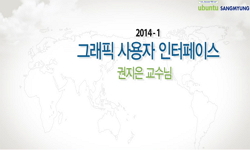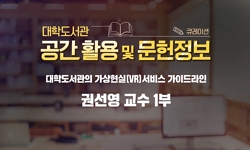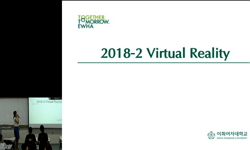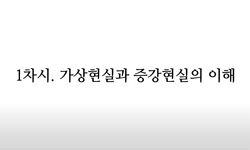With the recent 4th industrial revolution and advances in technology, the scope of VR utilization is expanding beyond just games into diverse fields like healthcare and education. With the development of these virtual technologies, global ICT companie...
http://chineseinput.net/에서 pinyin(병음)방식으로 중국어를 변환할 수 있습니다.
변환된 중국어를 복사하여 사용하시면 됩니다.
- 中文 을 입력하시려면 zhongwen을 입력하시고 space를누르시면됩니다.
- 北京 을 입력하시려면 beijing을 입력하시고 space를 누르시면 됩니다.
VR 웹 브라우저 정보탐색에서 시각적 단서가 사용자 경험에 미치는 영향 = A Study of the Effect of Visual Cue on User Experience in VR Information Search
한글로보기부가정보
다국어 초록 (Multilingual Abstract)
With the recent 4th industrial revolution and advances in technology, the scope of VR utilization is expanding beyond just games into diverse fields like healthcare and education. With the development of these virtual technologies, global ICT companies like Apple have confirmed the launch of VR and AR technologies through Vision Pro, expecting the popularization of virtual reality to accelerate even faster. As the virtual reality market expands, there is a need to pay attention to user interfaces for interaction within virtual reality. Thus, this study focuses on the pointer interface representing the user's actions within virtual reality, aiming to determine whether different types of visual cues of the pointer lead to differences in user experience during the virtual reality information search process.
This study was conducted as follows: First, through literature review, virtual reality was examined and previous studies on user experience in virtual reality were reviewed. Through the precedent studies, interactivity, usability and information were identified as major factors of user experience in virtual reality.
Also, it was discovered that while many technical studies have been conducted on the interaction between the virtual reality system and the user, there is a lack of visual studies on the virtual reality interface that users directly see and interact with. Therefore, after examining theories on affordance that guides user behavior and visual cues, this study defined the pointer, a user interface that increases interaction with users in virtual reality.
Secondly, in order to examine the differences in user experience according to the types of visual cues of the pointer in virtual reality, hypotheses and experiments were designed to conduct empirical research. The types of pointers are largely divided into those with no visual cues and those with visual cues. The types with visual cues are further categorized into the “information-embedded pointer” type that contains information within the pointer, and the “transforming pointer” type that changes form according to user actions. Experiment materials were produced accordingly. A total of 6 video experiment materials were produced by presenting 3 types of pointers according to differences in the sense of distance during the virtual reality information search process, and the experiment participants watched them wearing VR HMD devices. The experiment was conducted for 13 days from October 24, 2023 to November 5, 2023. A total of 60 experiment participants took part in the experiment offline. After watching the videos, the participants carried out a post-questionnaire evaluation consisting of a 5-point Likert scale, and additionally conducted 1:1 in-depth interviews for deriving insights.
The results analysis was conducted using one-way ANOVA, and the research findings are as follows:
First, it was found that users experience richer when the pointer inside virtual reality has a familiar form or when the changes in the pointer according to the user's input actions are distinct. Users prefer pointers with visual cues rather than those without, but it was identified that for the provided visual cues to be effective in usability and information, they need to be recognizable without additional learning. Also, through in-depth interviews, it was discovered that pointers that transform in shape according to user actions are evaluated especially positively when the transformations resemble actual hand shapes of users in actions like scrolling and dragging extending horizontally and vertically. This implies that even simple pointer forms can increase the virtual reality information transfer effect when they contain the user's objectives or actions inherently.
Secondly, it was discovered that different visual cues need to be provided according to the sense of distance between the user and screen in virtual reality. For users in closer environments, both the “information-embedded pointer” type and “transforming pointer” type garnered positive reactions, but in farther environments, the “information-embedded pointer” type showed lower average outcome values than the “transforming pointer” type in interactivity, usability, and information. Through these results and additional in-depth interviews, it was found that the farther the distance, noticeable changes are more effective for users in recognizing information, while adding small elements can rather make it difficult to properly grasp the meaning.
This study carried out suggestions for interfaces to improve user experience in virtual reality through empirical research, and discovered that the presence of visual cues embedded in pointers during the virtual reality user information search process leads to differences in user experience, and that depending on the
situation and user characteristics, different types of visual cues need to be provided. It is meaningful in that the study identified the necessity of new pointer interfaces in virtual reality for more accurate information acquisition and transfer, and proposed them. It is hoped that the results of this study can be utilized as
basic data for future research on user interfaces in virtual reality. In addition, based on this, follow-up studies need to research what forms of visual methods provided according to output interaction situations are more effective for the user experience.
국문 초록 (Abstract)
최근 4차 산업혁명과 함께 기술의 발전에 따라 VR의 활용 범위가 넓어지고, 게임뿐만 아닌 의료, 교육 등의 다양한 분야에서 VR을 사용하고 있다. 이러한 가상 기술의 발전과 함께 글로벌 ICT ...
최근 4차 산업혁명과 함께 기술의 발전에 따라 VR의 활용 범위가 넓어지고, 게임뿐만 아닌 의료, 교육 등의 다양한 분야에서 VR을 사용하고 있다. 이러한 가상 기술의 발전과 함께 글로벌 ICT 기업인 애플에서 VR과 AR 기술을 사용한 비전 프로 출시를 확정 지으며 가상현실의 대중화가 더욱 진행 빠르게 될 것으로 기대된다. 가상현실 시장이 확대되면서 가상현실에서의 상호작용을 위해 사용자 인터페이스에 주목할 필요가 있다. 이에 본 연구는 사용자의 행위를 나타내는 가상현실 내 포인터 인터페이스에 집중하여 가상현실 내 정보탐색 과정에서 포인터의 시각적 단서 유형에 따라 사용자 경험에 차이가 있는지를 알아보고자 하였다.
본 연구는 다음과 같이 진행된다. 첫째, 문헌 연구를 통해 가상현실에 대해 알아보고, 가상현실에서의 사용자 경험에 대한 선행연구를 살펴보았다. 선행연구를 통해 상호작용성, 사용성, 정보성을 가상현실 내 사용자 경험의 주요 요인으로 도출하였다. 또한, 현재 가상현실의 시스템과 사용자 간의 상호작용을 다루는 연구는 기술적인 측면에서는 많이 진행되고 있지만, 기기를 사용하는 사용자가 직접 시각적으로 접하고, 상호작용하는 가상현실 내 인터페이스에 관한 시각적 연구가 부족함을 발견하였다. 이에 본 연구는 사용자의 행동을 유도하는 어포던스와 시각적 단서에 대한 이론을 살펴본 후, 가상현실 내 사용자와의 상호작용을 높이는 사용자 인터페이스인 포인터를 정의하였다.
둘째, 가상현실 내 포인터의 시각적 단서 유형에 따른 사용자 경험의 차이를 살펴보고자 가설 설정 및 실험을 설계하여 실증적인 연구를 진행하였다. 포인터의 유형은 크게 시각적 단서가 없는 유형, 시각적 단서가 있는 유형으로 구분되며, 시각적 단서가 있는 유형은 포인터 내부에 정보가 포함된 ‘정보 포함 포인터’ 유형, 사용자의 행위에 따라 형태가 변하는 ‘형태 변형 포인터’ 유형으로 나누어 실험물을 제작하였다. 가상현실 내 정보탐색 과정에서 3가지의 포인터 유형을 거리감의 차이에 따라 제시하는 총 6개의 영상 실험물을 제작하였고, 실험 참여자들은 VR HMD 기기를 착용하여 이를 시청하였다. 실험은 2023년 10월 24일부터 2023년 11월 5일까지 13일간 이루어졌으며 총 60명의 실험자가 오프라인으로 실험에 참여하였다. 영상 시청이 끝난 후, 실험자들은 리커트 5점 척도로 구성된 사후 설문 평가를 진행하였으며, 인사이트 도출을 위하여 1:1 심층 인터뷰를 추가로 진행하였다.
결과 분석은 일원배치 분산분석(One-Way-ANOVA)으로 진행하였으며, 연구 결과는 다음과 같다.
첫째, 사용자는 가상현실 내 포인터가 익숙한 형태이거나 사용자가 입력하는 행동에 따른 포인터의 변화가 뚜렷할 때 사용자 경험이 풍부해지는 것을 알 수 있었다. 사용자는 시각적 단서가 없는 형태보다는 시각적 단서가 있는 포인터를 선호하지만, 제공되는 시각적 단서가 학습 없이도 인지 가능해야 사용성과 정보성 측면에서 효과적임을 알 수 있었다. 또한 사용자의 행위에 따라 형태가 변형되는 포인터는 특히 스크롤, 드래그 시 상하좌우로 늘어나는 형태처럼 실제 사용자의 손 모양을 내포하는 행동과 유사할수록 긍정적으로 평가한다는 것을 심층 인터뷰를 통해 발견하였다. 이는 단순한 형태의 포인터라도 사용자의 목적이나 행동이 내포되어 있을수록 가상현실 내 정보 전달 효과가 높아질 것을 의미한다.
둘째, 가상현실 내 사용자와 화면의 거리감에 따라 시각적 단서를 다르게 제공할 필요가 있음을 발견하였다. 거리가 가까운 환경에서의 사용자는 ‘정보 포함 포인터’ 유형과 ‘형태 변형 포인터’ 유형에 모두 긍정적인 반응이었지만, 거리가 먼 환경에서는 ‘정보 포함 포인터’ 유형의 상호작용성, 사용성, 정보성 항목은 ‘형태 변형 포인터’에 비하여 낮은 평균 결괏값을 보였다. 이러한 결과와 추가적인 심층 인터뷰를 통해 거리가 멀수록 사용자에게는 눈에 띄는 변화가 정보를 인지하기 효과적이며, 오히려 작은 요소 추가는 의미를 제대로 파악하기 어려움을 발견할 수 있었다.
본 연구는 가상현실 내 사용자 경험 향상을 위한 인터페이스 제안을 실증적 연구를 통해 진행하였으며, 가상현실 내 사용자의 정보탐색 과정에서 포인터에 내포된 시각적 단서의 유무가 사용자 경험에 차이를 나타내며 시각적 단서의 유형도 상황에 따라, 사용자 특성에 따라 다르게 제공되어 야 함을 발견하고 보다 정확한 정보 습득 및 전달을 위해 가상현실 내 새로운 포인터 인터페이스의 필요성을 밝히고 제안한 것에 의의가 있다. 본 연구의 결과는 향후 가상현실에서의 사용자 인터페이스 관련 연구의 기초 자료로 활용될 수 있기를 기대한다. 또한, 이를 기반으로 후속 연구에서는 시각적 단서가 출력 인터랙션 상황에 따라 어떠한 형태의 시각적 방식으로 제공되는 것이 사용자 경험에 더 효과적인지를 연구할 필요가 있을 것이다.
목차 (Table of Contents)
- I. 서 론 1
- 1.1. 연구 배경 및 목적 1
- 1.2. 연구 범위 및 방법 6
- II. 이론적 고찰 9
- 2.1. 가상현실 (VR) 9
- I. 서 론 1
- 1.1. 연구 배경 및 목적 1
- 1.2. 연구 범위 및 방법 6
- II. 이론적 고찰 9
- 2.1. 가상현실 (VR) 9
- 2.1.1. 가상현실(VR)의 이해 9
- 2.1.2. 가상현실(VR)과 상호작용 14
- 2.1.3. 가상현실(VR) 내 사용자 경험 18
- 2.2. 포인터 인터페이스 25
- 2.2.1. 사용자 인터페이스의 이해 25
- 2.2.2. 포인터 인터페이스의 출력 방식 28
- 2.3. 어포던스 32
- 2.3.1. 어포던스의 이해 및 유형 32
- 2.3.2. 물리적 어포던스 40
- 2.3.3. 가상현실에서의 어포던스 42
- 2.4. 시각적 단서 (Visual Cue) 45
- 2.4.1. 시각적 단서 (Visual Cue) 45
- 2.4.2. 거리감과 시각적 단서 47
- III. 연구 방법 49
- 3.1. 연구 모형 및 가설 49
- 3.2. 실험 절차 52
- 3.3. 실험 설계 54
- 3.3.1. 실험 방법 58
- 3.3.2. 설문지 구성 59
- IV. 연구 결과 60
- 4.1. 분석 방법 60
- 4.1.1. 분석 방법 60
- 4.1.2. 연구 대상자 인구통계학적 특성 61
- 4.2. 타당성 및 신뢰도 분석 62
- 4.2.1. 척도의 타당성 검증 결과 62
- 4.2.2. 척도의 신뢰도 검증 결과 63
- 4.3. 연구 문제 및 가설 검증 65
- 4.3.1. 가설 1 검증 65
- 4.3.2. 가설 2 검증 70
- 4.4. 심층 인터뷰 77
- Ⅴ. 결론 및 논의 81
- 5.1. 결론 및 시사점 81
- 5.2. 연구의 한계점 및 제언 85
- 참고문헌 86
- Abstract 98












